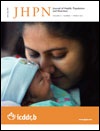Healthy Bread Initiative: Methods, Findings, and TheoriesIsfahan Healthy Heart Program
DOI:
https://doi.org/10.3329/jhpn.v31i1.14748Keywords:
Bread, Community trial, Health promotion, Nutrition, IranAbstract
The scientific evidences show that the content, baking methods, and types of bread can make health impacts. Bread, as a major part of Iranian diet, demonstrates a significant potential to be targeted as health promotion subject. Healthy Food for Healthy Communities (HFHC) was a project of Isfahan Healthy Heart Program (IHHP), consisting of a wide variety of strategies, like Healthy Bread (HB) Initiative. The HB Initiative was designed to improve the behaviour of both producers and consumers, mainly aiming at making high-fibre, low-salt bread, eliminating the use of baking soda, providing enough rest time for dough before baking (at least one hour), and enough baking time (at least one minute in oven). A workshop was held for volunteer bakers, and a baker-to-baker training protocol under direct supervision was designed for future volunteers. Cereal Organization was persuaded to provide less refined flour that contained more bran. Health messages in support of new breads were disseminated by media and at bakeries by health professionals. Evaluation of the HB Initiative was done using before-after assessments and population surveys. While HB was baked in 1 (0.01%) bakery at baseline, 402 (41%) bakeries in the intervention area joined the HB Initiative in 2009. Soda was completely eliminated and fibre significantly increased from 4±0.4 g% before study to 12±0.6 g% after the intervention (p<0.001). The preparation and baking times remarkably increased. Wastage of bread decreased from 13±1.8 g% to 2±0.5 g% and was expressed as the most important advantage of this initiative by consumers. People who lived in Isfahan city consumed whole bread 6 times more than those who lived in reference area Arak (p<0.001). The HB Initiative managed to add new breads as a healthy choice that were compatible with local dishes and made a model to solve the longstanding problems of bread. It used various health promotion approaches but was best consistent with Beatties model.
J HEALTH POPUL NUTR 2013 Mar;31(1):49-57
Downloads
218
192

